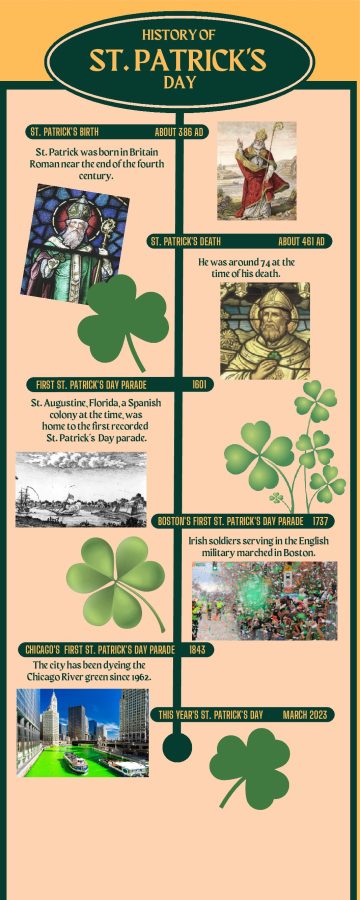A look into St. Patrick’s History
Leprechauns. Shamrocks. The color green. These iconic symbols have become synonymous with St. Patrick’s Day, a holiday honoring the culture and people of Ireland and the island’s patron saint.
Celebrated on March 17th in countries with large Irish populations, including the United States, St. Patrick’s Day has transformed over the centuries to become a celebration of Irish culture and pride
The holiday’s namesake was born in the 4th Century in Roman Britain, the son of a local official. In his adolescence, he was enslaved by Irish raiders and spent six years as a herdsman there, during which he became extremely devout. He managed to escape and fled back to Britain, where he was reunited with his family, but he wasn’t finished with Ireland. In his Confessio, a spiritual autobiography written towards the end of his life, he recalled a vivid dream in which the Irish people called out to him to return. Moved, he joined the Catholic Church and became the second missionary sent to Ireland. He played a significant role in the Christianization of the island, with the majority of the population having converted upon his death in 461. Multiple legends arose from his missionary work; shamrocks are associated with his holiday because he supposedly used them to explain the Holy Trinity to the people of Ireland, and the belief that he drove snakes out of Ireland is representative of him “driving out” paganism. St. Patrick died on the familiar date of March 17th, 461, and it only took a few centuries for his life to become immortalized in legend.
Seeing as St. Patrick became the patron saint of Ireland, the day of his death became a religious holiday in the country, but it took centuries and the pride of the Irish diaspora for it to transform into the holiday we recognize today. The first St. Patrick’s Day parade was probably held in 1601 in the Spanish colony of St. Augustine in Florida, and in the following centuries, Irish immigrants continued to celebrate St. Patrick’s Day in North America. Irish soldiers serving in the English military were responsible for Boston’s first St. Patrick’s Day parade in 1737, and New York City followed suit in 1762. Over time, the holiday shifted to become less a religious remembrance and more a celebration of Irish culture as a whole, especially in the United States. Iconic symbols of the holiday are Americanized aspects of traditional Irish culture, like leprechauns, which come from Celtic mythology. Corned beef and cabbage, a popular dish associated with St. Patrick’s Day, was a cheaper alternative of the traditional meal of ham and cabbage for Irish immigrants.
Today, St. Patrick’s Day is celebrated worldwide in countries with Irish diaspora. An adoption of modified aspects of traditional Irish culture by American society resulted in the unique holiday we’re familiar with today. Centuries of history and cultural traditions have led up to this year’s St. Patrick’s Day celebration on March 17th, 2023.





